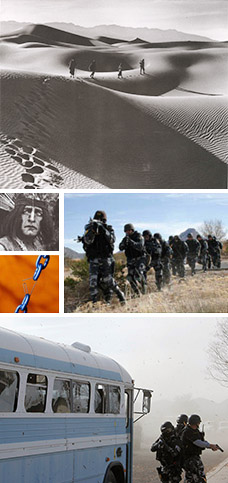
ngulfed by a tidal wav
e. He adds, in a footnote, that this woma
Email: n was then taken to an uninhabited island and given medicin
es to drive the tu
rtle spirit out of her. The medicine was too powerful. She fell into a coma and died.
Cuna Heaven: Cuna Paradox Baron Nordenskiold was impressed by what he saw as a certain Cuna paradox in absorbing the outside and changing world in order to stay the same. The Indi
ans were deeply conservative, he said, but very susceptible to novelty." The immediate stimulus to this observation wDoDas what he had been told about the journey of a Cuna soul after death, how decidedly Western, how decidedly modern and modernizing was the landscape of the dead that the soul passed through, yet how all this conspired to keep the Cuna the same. According to the baron, who got it from the Cuna Ruben Perez when he was relating things Cuna to the anthropologists in the Goteborg Museum in Sweden, the Cuna kingdom of the
dead is not only stuffed with Western consumer goods but is wide open t
-
o the winds of fashion and progress as well. "It is painted as a wond
erful dreamland," concluded the baron. "Much of it is taken from the white men and it is changed from time to time as the Indians have new experiences." Hence what appea -
rs as a horse drawn wagon in the 1920s will appear as an
automobile in the 1930s. "In other words," he goes on in an even more thought-provoking passage, in this Cuna society of -
the dead: The Indian is rich and the white man poor. Ever
ything which the white men now has, such as steamboats, automobiles, and trains, will belong in the other world to the Indians. Many of the souls of these objects already exist there. If a Cuna Indian can go aboard one of the ships which pass through the Panama Canal, then this ship will belong t -
o him in the next world. Perez used to s
ay jokingly that in the kingdom of the dead the Gothenburg Museum would belong to him. (291) We will have reason to return to this change in ownership of the Anthropological Museum in the future time of the dead Indian. For now, it is important to register this assemblage of Cuna -
life possessive of the
souls of Western commodities as a striking picture of what it can mean to stay the same by adapting to the white man's world, or to a crucial aspect of it, all of which we now start to see as crucially dependent on this strange word "adapting"-as when the ethnolinguist Joel Sherzer, for example, in his thoughtful study of Cuna speech, points out that despite cha -
nges such as the men working in the Canal Zone (and prior to that on white men's
ships), using new technology such as tape recorders, learning foreign languages, and so forth, such changes are integrated into Cuna life analogous to the "designs" created by Cuna women when integrating mousetraps, lunar modules, and baseball games into the traditional scheme of their appliqued shirtfronts- the famous molas, international sign of Cuna identity. In his words, "The Cuna ability to adapt should not be confused wi -
th acculturation. It is a con
The PSA measures the particles in a sample and displays the range of sizes present from 4 microns to 2000 microns. Particle size is often important in the control of industrial mixing, product preparation, and quality control and quality assurance for production facilities. -
stant, traditional feature of Cuna
social and cultural life to transform the new into the old, incorporating rather than rejecting. But this not so much resolves as restates what the baron's paradox problematizes, namely the very concepts - composing it-concepts such as tradition, transformation, and adaptation (without acculturation). Surely these concepts ate themselves glosses on a still more basic issue of identity, which has to be seen not
as a thing-in-itself but
- as I relationship woven from mimesis and alterity within colonial fields o
- f representation. Everything hinges on appearance. The Soul of the
- Flame Atomic Absorption spectroscopy
- Commodity Is Its
- Image which, Rele
- ased on Burning, Fascinates Dangerous Spirit
- s and Keeps Them from Doing Harm to Cunas A striking instance of the spiritual and hence imageric power
of EMRTCalterity provided by what Nordenskiold relates about certain cuEMRTCres of snakebite that were told to him. It must first be appreciated that snakebite is both a physical and a metaphysical cataclysm. Chapin describes it as a "crisis situation" in which the patient and the entire village become vulnerable to further attack by snake and allied spirits such as the spirits of the toad, which cause swelling, the squirrel fish, the morning star
, the fishhook (which cause great pain), and red animal spirits which cause hemorrhage. Sherzer also informs us that snakebite is a very "sensitive area" because the mainland, where the men tend crops and the women go for fresh water, abound

